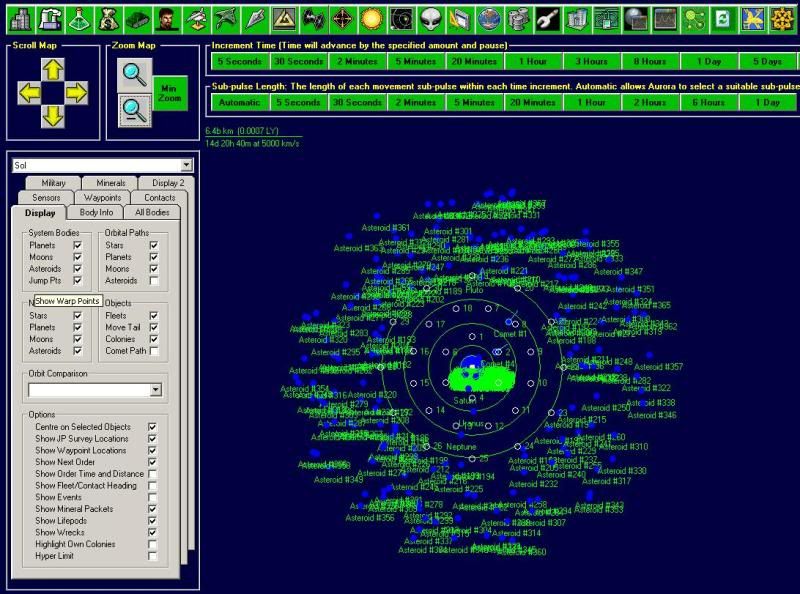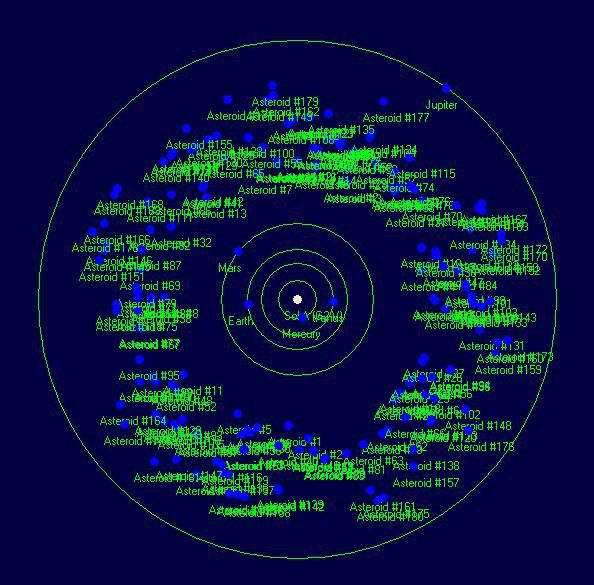I'll start off explaining by quoting our Supreme Avian Overlord, blue emu (which, btw, is part of our official State Religion. Just so you know.)
OK, time to start. When we first enter the Solar System, we are looking at it from a vantage point way out in the Oort Cloud.
Let's zoom in a little... past the Oort Cloud, past the outer Gas Giants, until the Inner System becomes visible.
There is Jupiter, the Asteroid belt and the Inner Planets. Let's zoom in a bit more:
... there we go. Good old Mother Earth.
The first thing we'll do is check out the general situation on Earth, since this will influence a lot of our other decisions.
Of course, his situation is not our situation.
Here is the summary tab (F2 window) in our version of Earth:
I'll go over these items one-by-one, from top to bottom.
Political status and Political Status modifiers:
This is an indication on how well the citizens of the planet are integrated in the greater society of Paradox. "Imperial Population" is the highest level: A fully functional integral part of our great nation. Lower levels are usually caused by conquest; A freshly conquered planet has a status of "Conquered", with a political status modifier of 20%. With time and given enough occupation forces (ground troops) on the ground, that status will increase, increasing the modifier in steps of 20%. How much time is dependant on both the size of the population and the current level; Reaching the higher levels takes more time than reaching the lower ones.
Species: Self-explanatory. Right now we only have access to the "human" race. Various races will have different requirements regarding the planetary environmental conditions. This is reflected in the next line item.
Planetary Suitability (colony cost): This modifier tells us how much space-age infrastructure (environmental domes, tubes, etc) is required for 1 million colonists to live upon this world. Earth, being fully terra-formed, requires no infrastructure.
In general, any planet with a value of 2 or below is generally very good and easily terraformed. Higher levels get progressively harder. More on this later, once we start actually building colonies

Administration level required: The required level of the planetary administrator. More population requires better admins. Governor Randakar has an admin rating of 5, so we should be good. For now.
One minor detail there: Apart from a planetary governor, there's also such a thing as a Sector governer. We however have build no Sector Command (which we'd need to research) so we cannot have one. Yet.
This is something to be recommended, though. Also, once you guys build that, I'll probably promote myself to sector governor

Annual wealth creation: Wealth is used for absolutely everything. Anything that has a build point or research point cost has a wealth cost identical to this number. For simplicity's sake, I'll equate 1000 wealth to 1 billion eurodollar in RP.
Population: 500 million inhabitants, divided over various sectors of industry. The bigger the population, the smaller the percentage of it that is available for actual manufacturing.
Infrastructure: See "Planetary suitability".
Manufacturing Sector Breakdown: Here is where the rubber meets the road. A single standard size installation takes 50.000 workers. This includes various types of factories, maintenance facilities, refineries, and mines. Research labs, Terraforming installations, and Genetic modification centres are 20 times bigger and also take 20 times as much population to run: 1 million workers. And some installations are fully automated and take no personell at all. This includes automated mines, deep space tracking stations, ground force training facilities, commercial spaceports, and military academies.
Note how we lose a few lines at the bottom in this screenshot. They say "Actual protection level: 0", "Tectonics: Earth-like", and "Geological Team Survey completed: No"
The protection level of a planet is a general measure of how much naval weaponry we have in the system. The requested level is how much of the population wishes to be protected; Big colonies will need lots of protection, small ones (smaller than 25 million inhabitants) are perfectly happy without it.
The geological team survey line indicates whether this planet's mineral supplies can be improved by having a team of 5 survey experts crawl the surface with high-sensitivity geological survey equipment. Earth has not been surveyed in such a manner yet, but we do know some rough basics. More on this later.
On the right-hand side, we find:
Military academy: This produces 5 officers per year per level and a fixed amount of crew men, modified by the racial training level. The default is a training level of 1, and 1000 crewmen per year per level. Training level 2 would divide that by 2, level 3 by 3, andsoforth, up until 5. Of course, higher training levels also mean ships crewed by them perform better. Right now we have 10.000 crewmen available at the racial training level of 1. (In the teams/academy tab of the F2 screen.. I'll get to that.)
Deep Space Tracking Station: This our planetary sensor net. It is a combined infrared / EM emissions detection system that detects infrared and EM signatures out to a range of (strength * signature strength * 1.000 km). So for a strength 1 signature, our system detects it at a range of 750.000 km. Which sounds like a lot, but with trans-newtonian speeds, a decent missile (with a speed of 20.000 km/sec) can cross that within about 40 seconds. Fast enough to not give inexperienced crews enough time to react to it.

The strength is actually a factor of the number of tracking stations (we have three right now) times the racial planetary sensor strength (250).
Maintenance Facility Maximum Ship Size: How big a ship our hodge-podge of ground based maintenance facilities can service. There is no limit to the number of ships it can handle (though they do all consume resources in the process) but there is a size limit.
Each facility adds 200 tons to the maximum ship size; We actually have 65 of them.
Shipyards / slipways: These are our shipyards. Each shipyard has a limit on how many ships it can build simultaneously, determined by the number of slipways. I'll explain more of that when we get to the Shipyards tab.
Maintenance facilities: See above.
Construction factories: The basis of our economy. They build everything that isn't being build by a shipyard, ordinance factory, or fighter factory. Each of these produces 10 construction points per year. That number can be improved through research, and is subject to leader bonuses from the planetary and sector governors, as well as penalties for political status economic status. A single construction point takes 1 point of wealth.
Ordnance Factories: As above, but limited to missiles, drones, buoys, and similar devices. There's a lot of flexibility in missile design, but you do have to build them somewhere.

Fighter Factories: Like construction factories, but these produce Fighter-class vessels. In general, those ships are smaller than 500 tons and employ fighter engines and components rather than regular ones. The advantage of these is that building them does not tie up expensive shipyard space, and do not require retools in order to begin production. Fighter factories use build points (BP) rather than construction points. In practice however these things are pretty much the same

Fuel refineries: Our 200 refineries convert Sorium (one of the TN minerals) to space ship fuel, currently at a rate of 4.800.000 liters / year. (So 24.000 liters per installation - also subject to research and leader bonuses, of course.)
Mines: These trans-newtonian ground-based mines produce 10 tons per available mineral per year each, modified by the mineral's accessibility rating, and take (yet again) 50.000 workers to run.
Automated mines: Like mines, but they don't require any people to run. These can be dropped on uninhabited rocks and start mining all on their own, producing stockpiles of minerals that can be either picked up by cargo vessels or slingshotted by mass driver to other colonies with mass drivers.
Research Labs: Our primary means of advancing technology. These huge installations are 20 times larger than regular installations and take 1 million people to run them. Each installation produces 200 research points, subject to the scientists'research bonus and specialisation. (More on that later.)
Ground Force training facilities: Each of these can produce one ground unit at a fixed rate. They require no population to be run, though I would not recommend dropping them on uninhabited worlds as I have no idea what would happen in such a case ;-)
More on this later, too.
Fuel Available: Liters of refined fuel available.
Maintenance supplies available: Military vessels (non-commercial ones) have breakdowns and can take damage. Both maintenance and repair takes maintenance supplies. These can be produced by construction factories.
Thermal / EM signature of colony: Inhabited worlds produce a lot of emissions which can be detected from space. Earth, being our primary home, produces enough that even our crappy sensor installations can spot the EM signature at a distance of 26.7 billion KM. Small ones, of course, produce a lot less.
Economic production modifier: If we run up a debt, this will go down. That is bad, since it slows down all construction.
Manufacturing Efficiency modifier: The net effect of economic and political modifiers combined.
Political modifiers: Does what it says on the tin. See "Political status" for more.
Current mining status:
These are the known deposits of the so-called trans-newtonian minerals on Earth. Each of them is used for a different set of purposes, except Duranium; That's used in absolutely everything.
The "Access" column is a modifier on the output of our mines; Access "1" means the mine applies it's full mining rate (right now, 10 tons per year) to it. Access "0.1" means it applies 1/10th of that rate - 1 ton per year.
Years to depletion is an estimate on how long those supplies will last at current production levels;
Stockpile is how much we have already mined and available for production;
Recent SP is how much these levels have changed since the last time increment (more on that later ..) and Mass Driver details how much mass drivers have affected that number.
Stockpile + production is what the level would be if nothing was used for a year;
And the projected usage tells us how many minerals we have queued up for use production - but, deceptively, in total, rather than for a period of one year.
Reserve level is something that will actually take effect in the next version of Aurora (5.70) but right now doesn't actually do anything.
As you can see, there is a LOT of complexity here. There are other sites and games that explain things better, but this should give you a general idea of what we're looking at.











or is it just coincidence?



Promotion or death!









